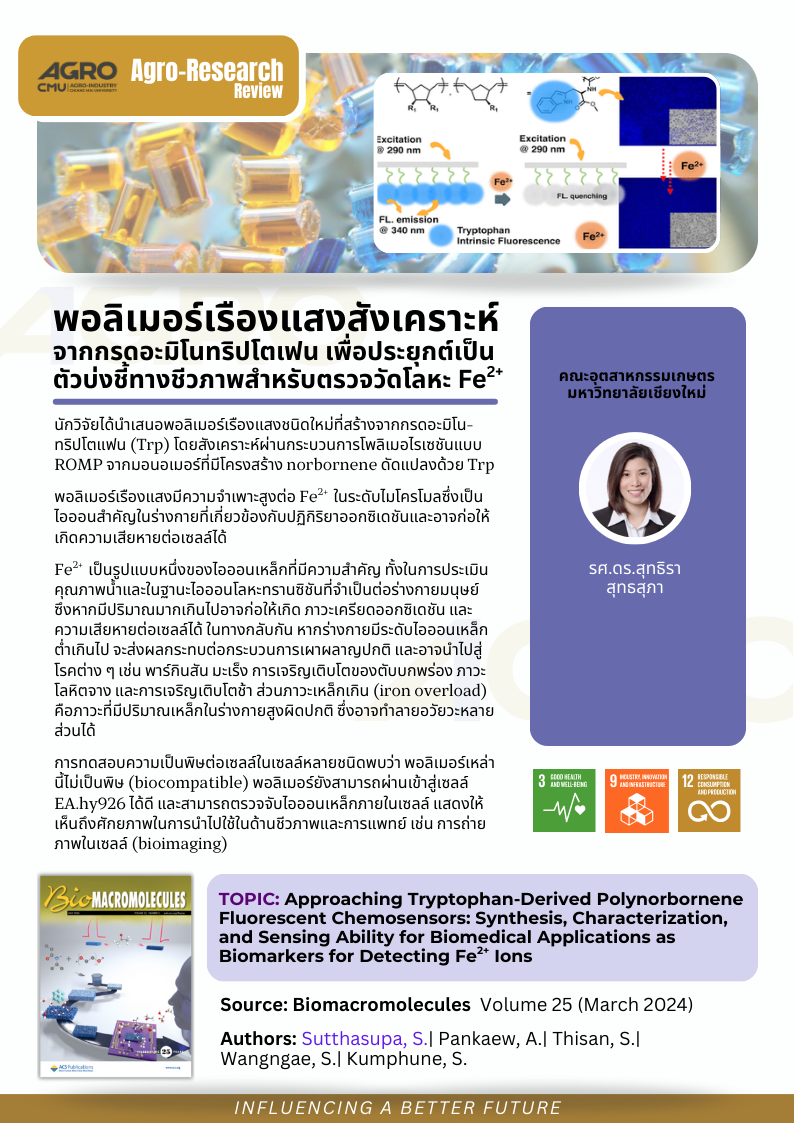
พอลิเมอร์เรืองแสงสังเคราะห์จากกรดอะมิโนทริปโตเฟนเพื่อประยุกต์เป็นตัวบ่งชี้ทางชีวภาพสำหรับตรวจวัดโลหะ Fe2+
นักวิจัยได้นำเสนอพอลิเมอร์เรืองแสงชนิดใหม่ที่สร้างจากกรดอะมิโน ทริปโตแฟน (Trp) โดยสังเคราะห์ผ่านกระบวนการโพลิเมอไรเซชันแบบ ROMP จากมอนอเมอร์ที่มีโครงสร้าง norbornene ดัดแปลงด้วย Trp
พอลิเมอร์เรืองแสงมี ความจำเพาะสูงต่อ Fe2+ ในระดับไมโครโมล ซึ่งเป็นไอออนสำคัญในร่างกายที่เกี่ยวข้องกับปฏิกิริยาออกซิเดชันและอาจก่อให้เกิดความเสียหายต่อเซลล์ได้
Fe2+ เป็นรูปแบบหนึ่งของไอออนเหล็กที่มีความสำคัญ ทั้งในการประเมินคุณภาพน้ำและในฐานะไอออนโลหะทรานซิชันที่จำเป็นต่อร่างกายมนุษย์ ซึงหากมีปริมาณมากเกินไปอาจก่อให้เกิด ภาวะเครียดออกซิเดชัน และความเสียหายต่อเซลล์ได้ ในทางกลับกัน หากร่างกายมีระดับไอออนเหล็กต่ำเกินไป จะส่งผลกระทบต่อกระบวนการเผาผลาญปกติ และอาจนำไปสู่โรคต่าง ๆ เช่น พาร์กินสัน มะเร็ง การเจริญเติบโตของตับบกพร่อง ภาวะโลหิตจาง และการเจริญเติบโตช้า ส่วนภาวะเหล็กเกิน (iron overload) คือภาวะที่มีปริมาณเหล็กในร่างกายสูงผิดปกติ ซึ่งอาจทำลายอวัยวะหลายส่วนได้
การทดสอบความเป็นพิษต่อเซลล์ในเซลล์หลายชนิดพบว่า พอลิเมอร์เหล่านี้ไม่เป็นพิษ (biocompatible) พอลิเมอร์ยังสามารถผ่านเข้าสู่เซลล์ EA.hy926 ได้ดี และสามารถตรวจจับไอออนเหล็กภายในเซลล์แสดงให้เห็นถึงศักยภาพในการนำไปใช้ในด้านชีวภาพและการแพทย์ เช่น การถ่ายภาพในเซลล์ (bioimaging)
-
Advanced Fluorescent Strip for Detecting Heavy Metals and Essential Amino Acids
Researchers developed a new fluorescent polymer derived from the amino acid tryptophan (Trp), synthesized via ring-opening metathesis polymerization (ROMP) of Trp-modified norbornene monomers. The fluorescent polymer shows high specificity toward Fe²⁺ ions at micromolar levels, an essential ion in the human body involved in redox reactions that can cause oxidative stress and cellular damage.
Fe²⁺ is significant not only for water quality assessment but also as a vital transition metal ion in the body. Excess Fe²⁺ can lead to oxidative stress and cell damage, while deficiency can disrupt normal metabolism, potentially leading to diseases such as Parkinson’s, cancer, impaired liver development, anemia, and stunted growth. Iron overload is a condition in which excessive iron accumulates in the body, potentially damaging multiple organs.
Cytotoxicity tests on various cell types confirmed that the polymers are biocompatible. They also demonstrated excellent cell permeability in EA.hy926 cells, enabling intracellular iron ion detection, indicating strong potential for biomedical and clinical applications such as bioimaging.
Topic: Approaching Tryptophan-Derived Polynorbornene Fluorescent Chemosensors: Synthesis, Characterization, and Sensing Ability for Biomedical Applications as Biomarkers for Detecting Fe2+ Ions
Authors: Sutthasupa, S.| Pankaew, A.| Thisan, S.| Wangngae, S.| Kumphune, S.
Abstract:
We present a novel group of tryptophan (Trp)-based fluorescent polymeric probes synthesized via ring-opening metathesis polymerization (ROMP) of Trp-derived norbornene monomers. These probes, in mono- and disubstituted forms, incorporate amide and ester anchoring groups. The quantity of Trp substituents did not affect fluorescence selectivity but influenced quenching percentage. Poly-diamide-Trp, Poly-monoamide-Trp, Poly-diester-Trp, and Poly-monoester-Trp probes displayed selective detection of Fe2+ and Fe3+ ions with fluorescence on–off characteristics. Poly-diamide-Trp and Poly-monoamide-Trp exhibited a limit of detection (LOD) for Fe2+ and Fe3+ ions of 0.86–11.32 μM, while Poly-diester-Trp and Poly-monoester-Trp showed higher LODs (21.8–108.7 μM). These probes exhibited high selectivity over Fe2+, a crucial metal ion in the body known for its redox properties causing oxidative stress and cell damage. Cell cytotoxicity tests in various cell types confirmed biocompatibility. Additionally, Poly-diamide-Trp displayed excellent cell permeability and iron ion detection in EA.hy926 cells, suggesting potential for bioimaging and clinical applications.
Keywords: Fluorescence; Hydrocarbons; Ions; Monomers; Probes
View at publisher: https://pubs.acs.org/doi/10.1021/acs.biomac.4c00021
#อกมช. #agrocmu #CMU





